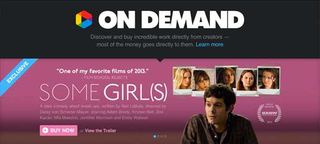Vimeo's Kerry Trainor on the future of online video
Vimeo may be David to YouTube's Goliath, but CEO Kerry Trainor has a plan that could change all that. He speaks to us about funding film-makers, shunning preroll ads, and the power of human curation.
When you're the web's second favourite video sharing platform, there are two ways you can go. You can try to do everything your rival, YouTube, does and beat them at their own game. Or you can carve out a unique path of your own, in a similar way to how Apple took on the PC through the 80s and 90s. Vimeo CEO Kerry Trainor is firmly in the latter camp. "We would love to be as big as YouTube - as long as we can remain as different as Vimeo," he explains.
He makes it quite clear that he's a fan of YouTube and doesn't want to replace it. "The world does not need another YouTube," he stresses. "What it provides to a very mass-based audience is a wildly successful platform. The reason Vimeo has been rewarded with the growth that it has - over 100 million users per month now - is that the Vimeo experience is very different."
Luring the creators

There are many ways the platform distinguishes itself in Trainor's eyes, but what it essentially boils down to is this: "Vimeo as a platform is about empowering creators," he says, "by offering them the very best tools to upload and share and distribute, and ultimately monetise video." And by creators, he's not talking about the common populace filming funny cats on their mobile phones, but professional film-makers aiming to produce quality work.
And Vimeo is also putting its money where its mouth is, announcing today that it's offering a $10,000 cash advance to all 150 films being premiered at the upcoming Toronto International Film Festival. The film makers need only agree to exclusively launching their films on the pay-per-view Vimeo on Demand service for 30 days.
Funding the film-makers
It's a bold move, and one that offers a potentially bright future to indie film-makers. Festival films are often superior in terms of acting and story than a lot of big-budget Hollywood fare, but can struggle to get seen outside of the circuit. Could Vimeo on Demand help to bring a new generation of niche films to the masses?
Trainor certainly hopes so. "It's about getting more professional level content into the Vimeo on Demand catalogue that oftentimes won't find its way to audiences through professional channels," he explains. "Vimeo has always been a core part of the film festival community, we love the Toronto festival, and we know there's going to be a load of great new work coming."
Vimeo has always been a core part of the film festival community
Whether the scheme is extended to future festivals will depend on how things play out with Toronto, but Trainor sees no reason why not. Film-makers in general are already being lured by the fact that Vimeo only takes 10 per cent of the revenue raised for online viewings, and that's not likely to change, says Trainer.
"We want creators to feel this is a platform that really empowers them to control their own destiny as much as possible," he stresses.
Hollywood future?
Indeed there's no reason that, in the long term, that can't include the big budget productions. "The exciting thing is that technically, there are no limitations preventing us from continuing to attract different types of content that could go all the way through to traditional Hollywood film or television content," Trainor enthuses.
We want creators to feel this is a platform that really empowers them
That's a possibility, not a certainty, though: "We have not made the decision yet to go full bore after that," he says. "It is a quite expensive and crowded fight right now with Netflix and Hulu and others. But we do believe we can amass a very unique catalogue of content around the types of things we see at Toronto as well as many other areas."
Luring the consumers

But if that's how Vimeo is luring the creators, what of the consumers? There are many aspects to Vimeo that make it appealing to viewers, Trainor believes: the focus on quality, HD content; the technical smoothness of the delivery; and the way 'Staff Picks' help people cut through the noise.
"Staff Picks are something we think really distinguishes Vimeo," he says. "With all the power that the internet offers in terms of search and discovery, there's still a very distinct feel to a human-curated experience. It brings out a lot of nuance and serendipity that even the most sophisticated search engine might not necessarily deliver. We're very passionate about representing the diversity of content of Vimeo so we are looking at ways to make that even more prominent."
Preroll ads
But the most notable difference from YouTube, as far as the consumer is concerned, is probably the lack of preroll ads. And the good news is, Trainor says, that's certain to continue.
"Interruptive advertising in the stream as it's formed today is not something that will work for Vimeo," he says. "I know that will be a huge part of the video advertising picture on the internet, and perhaps even the majority of the dollars. But brands are also expanding into far more diverse type of video communications than the typical 30-second preroll spot that we see today."
Interruptive advertising in the stream as it's formed today is not something that will work for Vimeo
"Brands are doing more storytelling," he continues. "Whether it's longer form or shorter form, they're doing different types of video to support campaigns - like what we're doing with Brand Creative Fund."
Brand solutions

The Brand Creative Fund is a recently introduced scheme that involves Vimeo matching marketing agencies with creative filmmakers to make short (or even feature) films designed to be shared socially in their own right, as opposed to forcibly inserted in other content. The first brand to take up the offer was the Lincoln Motor Company - you can see the videos produced for its campaign here.
And this is not just a gimmick, but something that Vimeo sees as central to its evolving business model. "I believe the preroll economy is going to be tens of billions of dollars on the internet," Trainor says. "But I also have no doubt that these other forms of video will represent billions of dollars."
But surely tens of billions are more tempting? "I think it would be very uninteresting of Vimeo to announce to the world that we're going to be the number eight preroll network," Trainor responds. "I think it's far more interesting to help point the way towards video being used in a non-interruptive storytelling way for brands, and have us be the leader of that, around quality and creativity."
Liked this? Read these!
- The best 3D movies of 2013
- Discover what's next for Augmented Reality
- Download free textures: high resolution and ready to use now
What's your preferred video platform? Let us know your views in the comments below!

Thank you for reading 5 articles this month* Join now for unlimited access
Enjoy your first month for just £1 / $1 / €1
*Read 5 free articles per month without a subscription

Join now for unlimited access
Try first month for just £1 / $1 / €1
Get the Creative Bloq Newsletter
Daily design news, reviews, how-tos and more, as picked by the editors.
The Creative Bloq team is made up of a group of design fans, and has changed and evolved since Creative Bloq began back in 2012. The current website team consists of eight full-time members of staff: Editor Georgia Coggan, Deputy Editor Rosie Hilder, Ecommerce Editor Beren Neale, Senior News Editor Daniel Piper, Editor, Digital Art and 3D Ian Dean, Tech Reviews Editor Erlingur Einarsson and Ecommerce Writer Beth Nicholls and Staff Writer Natalie Fear, as well as a roster of freelancers from around the world. The 3D World and ImagineFX magazine teams also pitch in, ensuring that content from 3D World and ImagineFX is represented on Creative Bloq.
